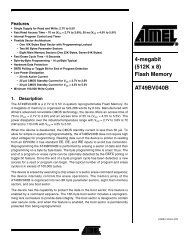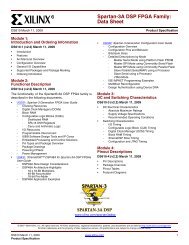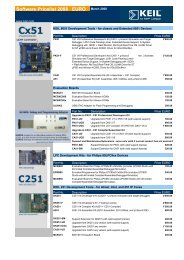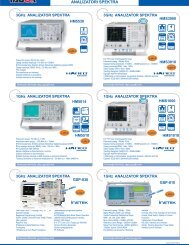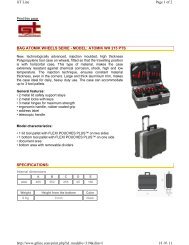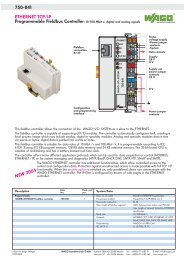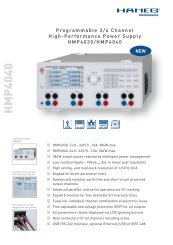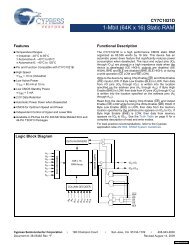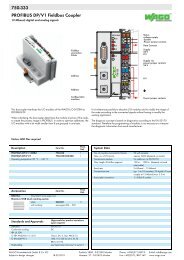PIC12F683 Data Sheet - Microchip
PIC12F683 Data Sheet - Microchip
PIC12F683 Data Sheet - Microchip
You also want an ePaper? Increase the reach of your titles
YUMPU automatically turns print PDFs into web optimized ePapers that Google loves.
<strong>PIC12F683</strong><br />
9.1.5 INTERRUPTS<br />
The ADC module allows for the ability to generate an<br />
interrupt upon completion of an Analog-to-Digital<br />
conversion. The ADC interrupt flag is the ADIF bit in the<br />
PIR1 register. The ADC interrupt enable is the ADIE bit<br />
in the PIE1 register. The ADIF bit must be cleared in<br />
software.<br />
Note:<br />
The ADIF bit is set at the completion of<br />
every conversion, regardless of whether<br />
or not the ADC interrupt is enabled.<br />
This interrupt can be generated while the device is<br />
operating or while in Sleep. If the device is in Sleep, the<br />
interrupt will wake-up the device. Upon waking from<br />
Sleep, the next instruction following the SLEEP<br />
instruction is always executed. If the user is attempting<br />
to wake-up from Sleep and resume in-line code<br />
execution, the global interrupt must be disabled. If the<br />
global interrupt is enabled, execution will switch to the<br />
interrupt service routine.<br />
Please see Section 12.4 “Interrupts” for more<br />
information.<br />
9.1.6 RESULT FORMATTING<br />
The 10-bit A/D conversion result can be supplied in two<br />
formats, left justified or right justified. The ADFM bit of<br />
the ADCON0 register controls the output format.<br />
Figure 9-3 shows the two output formats.<br />
FIGURE 9-3:<br />
10-BIT A/D CONVERSION RESULT FORMAT<br />
ADRESH<br />
ADRESL<br />
(ADFM = 0) MSB LSB<br />
bit 7 bit 0 bit 7 bit 0<br />
10-bit A/D Result Unimplemented: Read as ‘0’<br />
(ADFM = 1) MSB LSB<br />
bit 7 bit 0 bit 7 bit 0<br />
9.2 ADC Operation<br />
9.2.1 STARTING A CONVERSION<br />
To enable the ADC module, the ADON bit of the<br />
ADCON0 register must be set to a ‘1’. Setting the<br />
GO/DONE bit of the ADCON0 register to a ‘1’ will start<br />
the Analog-to-Digital conversion.<br />
Note:<br />
Unimplemented: Read as ‘0’<br />
The GO/DONE bit should not be set in the<br />
same instruction that turns on the ADC.<br />
Refer to Section 9.2.6 “A/D Conversion<br />
Procedure”.<br />
9.2.2 COMPLETION OF A CONVERSION<br />
When the conversion is complete, the ADC module will:<br />
• Clear the GO/DONE bit<br />
• Set the ADIF flag bit<br />
• Update the ADRESH:ADRESL registers with new<br />
conversion result<br />
10-bit A/D Result<br />
9.2.3 TERMINATING A CONVERSION<br />
If a conversion must be terminated before completion,<br />
the GO/DONE bit can be cleared in software. The<br />
ADRESH:ADRESL registers will not be updated with<br />
the partially complete Analog-to-Digital conversion<br />
sample. Instead, the ADRESH:ADRESL register pair<br />
will retain the value of the previous conversion. Additionally,<br />
a 2 TAD delay is required before another acquisition<br />
can be initiated. Following this delay, an input<br />
acquisition is automatically started on the selected<br />
channel.<br />
Note:<br />
A device Reset forces all registers to their<br />
Reset state. Thus, the ADC module is<br />
turned off and any pending conversion is<br />
terminated.<br />
© 2007 <strong>Microchip</strong> Technology Inc. DS41211D-page 63



